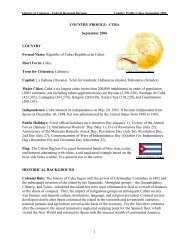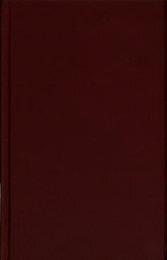Anton Webern's Six Pieces for Ocrhestra, op. 6, Arrangement for ...
Anton Webern's Six Pieces for Ocrhestra, op. 6, Arrangement for ...
Anton Webern's Six Pieces for Ocrhestra, op. 6, Arrangement for ...
You also want an ePaper? Increase the reach of your titles
YUMPU automatically turns print PDFs into web optimized ePapers that Google loves.
which the members of the Second Viennese School had increasingly ad<strong>op</strong>ted ever<br />
since Schoenberg's Chamber Symphony of 1906. Schoenberg himself had raised this<br />
principle to the status of an independent category of instrumentation in an<br />
unpublished note of April 16, 1917, contrasting it with a (Romantic) "organ-like<br />
(registration) instrumentation," 19 and in a letter to Alexander Zemlinsky of February<br />
20, 1918, he had even applied the term to certain passages in one of his early works,<br />
the Symphonoc Poem Pelleas and Melisande. 20 (This does not mean, of course, that<br />
"soloistic instrumentation," was invented by Schoenberg, even though some of his<br />
pieces served as models <strong>for</strong> many later composers of the Second Viennese School<br />
as well as <strong>for</strong> others.) 21 And Webern too had turned to "soloistic instrumentation" as<br />
early as 1911 (in the orchestral pieces that were later published as <strong>op</strong>. 10)--a<br />
tendency he exhibited more and more in his subsequent works such as the Trakl and<br />
Rosegger songs (<strong>op</strong>p. 14 and 15, begun in 1917). It is no surprise, then, to find in<br />
his letters the following remark on the arranging practice of the Verein: "I take<br />
much pleasure in these arrangements. If you think of my most recent scores-- which<br />
are essentially <strong>for</strong> chamber orchestra (nothing but solo parts)--you will understand<br />
how close this is to my heart." 22<br />
Arranging orchestral scores <strong>for</strong> the Verein was thus not simply a matter of<br />
necessity; it was also a matter of subjecting the original works to a new instrumental<br />
interpretation and, in the process, of probing their substance. Such a critical<br />
undertaking is aptly described in the following words of Alban Berg, which imply<br />
that instrumental "color" was no longer considered to be a primary, <strong>for</strong>mative<br />
element (as in the years be<strong>for</strong>e the First World War), but merely served to clarify<br />
musical structure:<br />
In this manner [i.e., by using transcriptions of orchestral scores] it is possible to hear<br />
and judge a modern orchestral work divested of all the sound-effects and other<br />
sensuous aids that only an orchestra can furnish. Thus the old approach is robbed of<br />
its <strong>for</strong>ce--that this music owes its power to its more or less <strong>op</strong>ulent and effective<br />
instrumentation and lacks the qualities that were hitherto considered characteristic<br />
of good music--melody, richness of harmony, polyphony, perfection of <strong>for</strong>m,<br />
architecture, etc. 23<br />
It must be kept in mind, however, that when Berg spoke of renouncing all<br />
"sensuous aids" he meant the earlier Verein practice of piano transcription. In<br />
contrast, the transcription <strong>for</strong> chamber ensemble involved merely a reduction of<br />
such aids, one that managed to present the essence of a work by different means, but



![Albert Einstein Papers [finding aid]. Library of Congress. [PDF ...](https://img.yumpu.com/21604228/1/190x245/albert-einstein-papers-finding-aid-library-of-congress-pdf-.jpg?quality=85)





![American Colony in Jerusalem Collection [finding aid]. Library of ...](https://img.yumpu.com/17941275/1/190x245/american-colony-in-jerusalem-collection-finding-aid-library-of-.jpg?quality=85)



![Piccard Family Papers [finding aid]. - American Memory - Library of ...](https://img.yumpu.com/17941234/1/190x245/piccard-family-papers-finding-aid-american-memory-library-of-.jpg?quality=85)


